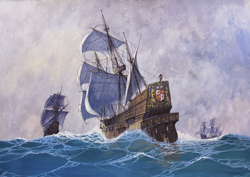Medieval ship building and repair practices uncovered
Tar and pitch, sticky substances manufactured from trees, were widely used in medieval times to preserve wood and to provide waterproofing. The EU-funded 'Ancient maritime pitch and tar: A multidisciplinary study of sources, technology and preservation' (AMPT) project set out to understand the impact of burial environment on tar and pitch degradation. AMPT researchers also hoped to shed light on medieval ship-building and maintenance practices. Gas chromatography-mass spectrometry (GC-MS) and isotopic analysis was used to identify the range and sequence of tars used on the Newport Ship and to study how the tar degraded in comparison with tar from other excavated ships. Researchers were able to distinguish tars used for building and later repair work. These tars differed in both chemical composition and geographical source. The effects of degradation were found to be highly variable but the researchers were able to link some specific degradation products to particular burial environments. The AMPT project showed that tar and pitch analysis can prove useful for broad observations of construction and repair in ancient ships. The research also demonstrated the significant impact that degradation of tar and pitch has on interpretations that can be drawn from the chemical composition. The findings add to the body of knowledge on the preservation of maritime museum collections.



